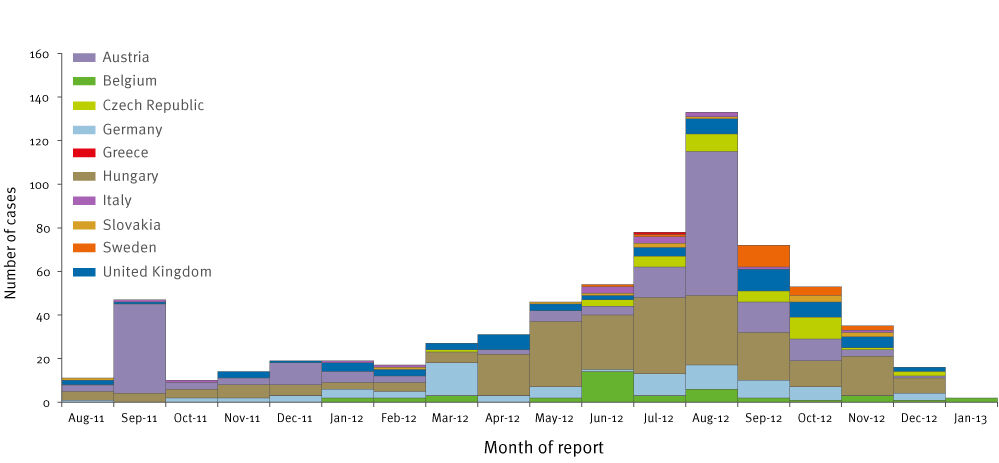Epidemiological update: multistate outbreak of Salmonella Stanley infection, 30 January 2013
In July 2012, the European Centre for Disease Prevention and Control (ECDC) initiated a Europe-wide investigation on a Salmonella Stanley outbreak, together with the affected Member States, the European Food Safety Authority (EFSA) and the European Reference Laboratory for Salmonella (EURL Salmonella). Cases were associated with strains showing an indistinguishable PFGE pattern not previously reported in Europe.
Epidemiological and microbiological outbreak investigation at the European Union level
In July 2012, the European Centre for Disease Prevention and Control (ECDC) initiated a Europe-wide investigation on a Salmonella Stanley outbreak, together with the affected Member States, the European Food Safety Authority (EFSA) and the European Reference Laboratory for Salmonella (EURL Salmonella). Cases were associated with strains showing an indistinguishable PFGE pattern not previously reported in Europe.
Between July and September 2012, ECDC encouraged European Union (EU) and other European Economic Area (EEA) Member States to perform Xbal-PFGE typing on all S. Stanley human isolates. The image profile of the outbreak strain was shared with all EU countries. ECDC collected and analysed molecular typing data on S. Stanley from EU/EEA Member States to explore potential sources of infection within the food production chain in this multi-country outbreak.
Following the publication of the joint ECDC/EFSA rapid risk assessment on 20 September 2012, ECDC suggested to the EU/EEA Member States to perform PFGE typing only on a subset of isolates, and to report to ECDC the number of non-travel associated S. Stanley cases on a monthly basis, regardless of travel history within or outside the EU. The objective of this update is to monitor the evolution of the outbreak. Although the case definition for this monitoring purpose is broader than during the intensive phase of the outbreak (higher sensitivity), the epicurve provides an indication of the development of the outbreak. ECDC will provide a monthly update of the situation in the EU/EEA until the outbreak is considered over.
Ten EU Member States have had cases with PFGE results matching the PFGE outbreak profile. These countries were asked to provide the number of non-travel related cases of S. Stanley (i.e. probable and confirmed cases) identified per month between 1 August 2011 and 23 January 2013.
From 2007 to 2011, an average of nine cases of non-travel related S. Stanley infections were reported monthly to The European Surveillance System (TESSy) in EU/EEA Member States.
Epidemiological update
Between 1 August 2011 and 23 January 2013, 684 cases of non-travel-related S. Stanley infections (probable and confirmed cases*) were identified in the EU: Hungary (235), Austria (186), Germany (77), Belgium (41), the United Kingdom (64), Czech Republic (35), Sweden (18), Italy (14), Slovak Republic (12), and Greece (1) (Figure 1). * See case definition at the end of the document
Figure 1: Distribution of cases of non-travel-related Salmonella Stanley infections (probable and confirmed cases*) by Member States and month of report, August 2011 – January 2013, as of 23 January. (n=684)

The monthly number of cases reported has decreased consecutively from the peak in August 2012 (n=133) to December (n=16), and is close to the pre-outbreak rate (n=9/month). As the exclusion criteria refer to PFGE testing, and probable cases have not been tested by PFGE, the overall number of case reports shown here may slightly overestimate the actual size of the outbreak. Additionally, the antibiotic resistance pattern of some probable cases suggests that they are not part of the outbreak, although comparison of resistance patterns is not as reliable an epidemiological marker as PFGE testing. In spite of these uncertainties for a small fraction of cases, the pattern of epidemiological curve provides essential information on the resolution of this outbreak.
Microbiological update
Comparative molecular epidemiological analyses of human, food, animal and environmental isolates’ PFGE fingerprints performed by ECDC and the EURL Salmonella corroborate the available epidemiological evidence. This provides additional evidence that strongly supports the conclusions of the ECDC/EFSA rapid risk assessment of 21 September 2012, in particular the implication of the turkey production chain as the probable main source of the outbreak.
Conclusions
The number of cases represented in this update provides an indication of the trend of the outbreak. The monthly number of cases has decreased for five consecutive months towards the pre-outbreak rate, suggesting a reduction in exposure to the vehicle for the infections. However, the monthly number of non-travel related cases reported in December in the 10 affected countries exceeds the pre-outbreak rate observed for the EU as a whole. Therefore the outbreak cannot yet be considered as over.
ECDC will monitor the monthly number of cases in affected countries again next month to confirm the end of the outbreak. If this is achieved, surveillance for re-emergence of the outbreak will be achieved thereafter through updates from EU Member States to ECDC, e.g. via the Epidemic Intelligence Information System for Food and Waterborne Diseases (EPIS-FWD), and through analysis of trends in reports of non-travel related S. Stanley submitted to TESSy by Member States.
A joint ECDC/EFSA rapid risk assessment was published on 21 September 2012.
* EU epidemic case definition for Salmonella Stanley multi country outbreak Confirmed case A laboratory confirmed case of Salmonella Stanley with PFGE pattern matching the ‘Belgium outbreak strain’AND Onset of symptoms after August 2011AND Without travel history outside the EU in 1–7 days prior the onset of symptomsProbable caseA laboratory confirmed case of Salmonella Stanley, no PFGE available AND Onset of symptoms after August 2011AND Without travel history outside the EU in 1–7 days prior the onset of symptomsExclusion criteria If the Salmonella Stanley strain has a different PFGE profile it should be excluded.







